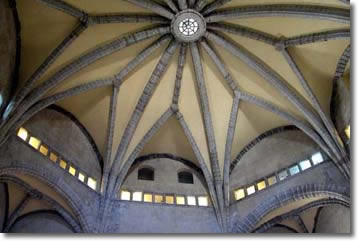
- The Barons' Hall (photograph by Andrea Della Rossa)
This was once the "Sala Mayor" or Main Hall of the Angevin Castle, built under the order of Robert of Anjou and frescoed by Giotto about 1330 with representations of men (and their women) of antiquity: Samson, Hercules, Solomon, Paris, Hector, Achilles, Aenea, Alexander and Caesar, probably with their "partners".
The images of this cycle of frescoes has unfortunately been lost, but they are described by the anonymous author of a collection of sonnets of about 1350. During the reign of Alfonso d'Aragona (1442-1458), the Hall was restructured and enlarged by the Majorcan architect Guillén Sagrera, who used only a part of the small Angevin hall.
This imposing place is the most famous of the castle and is called the "Barons' Hall" because in 1486 the barons who had plotted against Ferrante I of Aragon were arrested here, after being invited by the king himself to celebrate his grandaughter's marriage to the son of the Count of Sarno.
Above the bare walls the superb dome vault rises to a height of twenty-eight metres, and instead of the traditional keystone at its centre, there is a bright oeil-de-boeuf from which radiate sixteen piperno vaulting-ribs that, together with other minor elements take the form of a star highlighting the chromatic contrast between the grey of the ribs in Pozzuoli piperno and the yellow tuff of the walls and the vault. Below the vault is a gallery with eight square windows for each of the lunettes above.
The hall was damaged by fire in 1919 and almost all the sculptures were destroyed. To the left of the entrance portal we see the two-faced marble portal by Domenico Gagini, providing communication between the Hall and the apartments of the Aragonese kings. The architraves were partly destroyed by the fire, but two bas-reliefs remain; the one facing the Hall is about Alfonso's Triumphal Procession, while the other represents the King's Entrance into the Castle. On the northern wall, a much-ruined Catalan portal leads to the Chamber of the Angels, so called because of the angels pictured in the frescoes.
Between the two windows on the sea view side, each made quadripartite by a piperno cross, there is a large rectangular fireplace overhung by two music galleries decorated with two transennae, which have been destroyed, and with a flamboyant design similar to the rose window of the Palatine Chapel.
A gothic door in the south-east corner of the Hall leads to the spectacular, though unfit for use, winding staircase, all of piperno, which from the apse of the Palatine Chapel winds up to the Barons' Hall and the terraces above. The place is lit by a balcony called "Triumphal" the base of which is original, in the form of an upside-down pyramid, decorated with exquisite carvings in majorcan stone.
The floor of the Great Hall was of glazed white and blue majolica from the Valencia works. At present the Hall is used for the meetings of the Town Council.